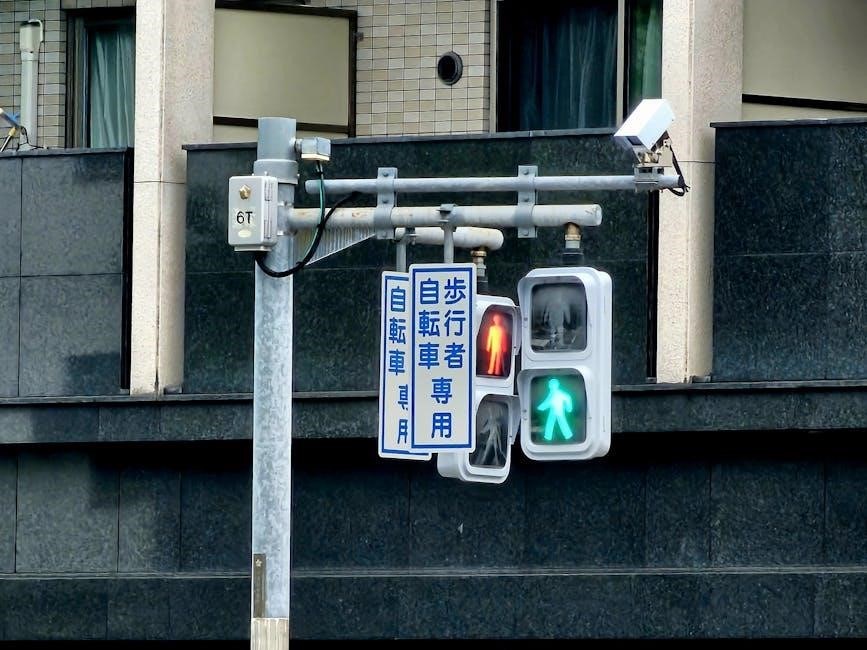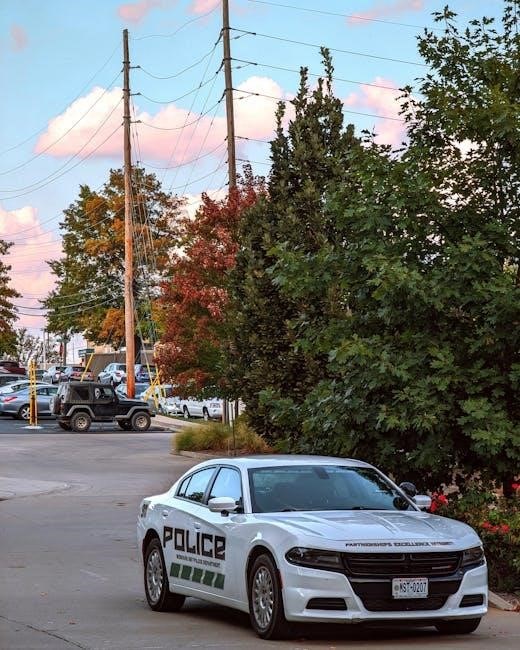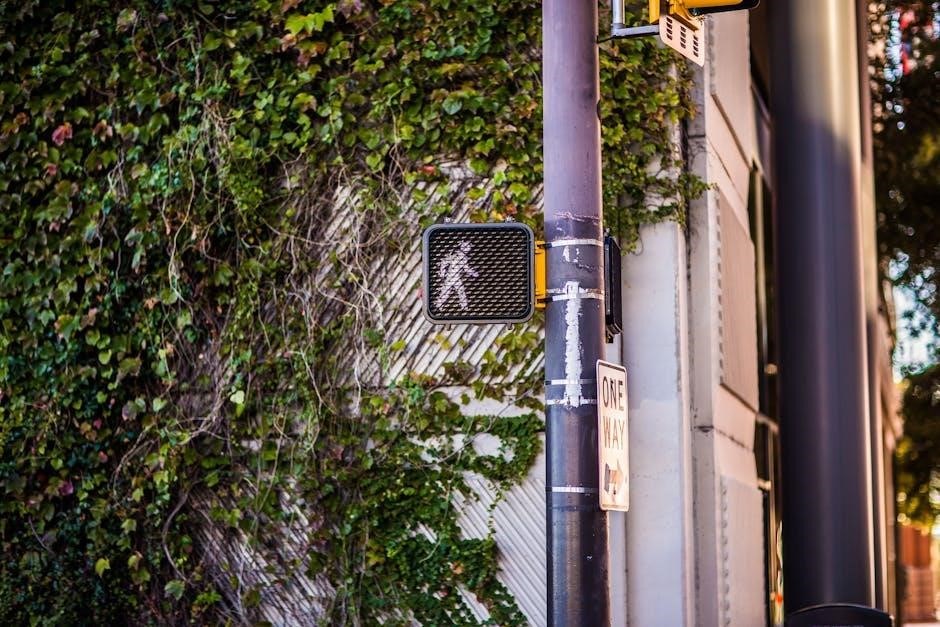txdot traffic control plan pdf
The TxDOT Traffic Control Plan (TCP) PDF outlines guidelines for ensuring safety and efficiency in work zones․ It provides detailed frameworks for temporary traffic control devices‚ pavement markings‚ and work zone signage‚ complying with TMUTCD standards to minimize disruptions and risks during construction or maintenance activities․
1;1 Overview of the TxDOT Traffic Control Plan
The TxDOT Traffic Control Plan (TCP) is a comprehensive document designed to ensure safe and efficient traffic management during construction‚ maintenance‚ or other activities impacting roadways․ It provides standardized guidelines for temporary traffic control devices‚ construction pavement markings‚ and work zone signage‚ aligning with the Texas Manual on Uniform Traffic Control Devices (TMUTCD)․ The plan is tailored to address specific project requirements‚ ensuring minimal disruption to traffic flow while maintaining safety for both workers and road users․
Key components include detailed layouts for traffic control devices‚ such as signs‚ barricades‚ and pavement markings‚ as well as sequences for implementing phases of traffic control․ The TCP also emphasizes compliance with federal and state regulations‚ ensuring consistency and adherence to best practices․ By providing clear instructions and visual representations‚ the TxDOT TCP serves as a critical resource for contractors‚ engineers‚ and stakeholders involved in roadway projects․

Ultimately‚ the plan aims to balance safety‚ efficiency‚ and compliance‚ making it an essential tool for managing traffic in work zones effectively․ Its structured approach ensures that all aspects of traffic control are addressed‚ from initial setup to final removal of devices‚ fostering a secure environment for both construction activities and public travel․
1․2 Purpose of the Traffic Control Plan (TCP)

The primary purpose of the Traffic Control Plan (TCP) is to ensure the safe and efficient movement of traffic through or around work zones․ It provides a detailed framework for managing traffic flow during construction‚ maintenance‚ or other roadway activities‚ prioritizing the safety of both workers and road users․ The TCP outlines the necessary measures to minimize disruptions‚ reduce accidents‚ and maintain order in work zones․
The plan serves as a critical tool for contractors‚ engineers‚ and stakeholders to comply with federal and state regulations‚ particularly the Texas Manual on Uniform Traffic Control Devices (TMUTCD)․ By establishing clear guidelines for the placement of temporary traffic control devices‚ signs‚ and pavement markings‚ the TCP helps maintain traffic flow while safeguarding the public and work crews․ Its implementation ensures that all activities are conducted in a manner that balances safety‚ efficiency‚ and regulatory compliance‚ ultimately protecting lives and preventing delays․
1․3 Scope of the TxDOT Traffic Control Plan PDF
The scope of the TxDOT Traffic Control Plan PDF encompasses comprehensive guidelines for managing traffic during construction‚ maintenance‚ and utility operations on Texas roadways․ It covers the selection‚ placement‚ and maintenance of temporary traffic control devices‚ including signs‚ pavement markings‚ and barriers․ The document ensures compliance with the Texas Manual on Uniform Traffic Control Devices (TMUTCD) and addresses various work zone scenarios‚ from short-term lane closures to long-term construction projects․
The plan applies to all public roadways under TxDOT jurisdiction and provides standardized procedures for contractors‚ engineers‚ and traffic control personnel․ It emphasizes adaptability to different project scales and conditions‚ ensuring that traffic control measures are tailored to specific work zone requirements․ By adhering to the guidelines outlined in the TxDOT Traffic Control Plan PDF‚ stakeholders can ensure the safety of both workers and motorists while maintaining efficient traffic flow throughout the project duration․

Key Components of a Traffic Control Plan
A Traffic Control Plan (TCP) includes temporary traffic control devices‚ construction pavement markings‚ work zone signs‚ and traffic control sequences․ These components ensure safe and efficient traffic flow through work zones‚ minimizing disruptions and risks․
2․1 Temporary Traffic Control Devices
Temporary Traffic Control Devices (TTC) are essential for maintaining safety and order in work zones․ These devices include cones‚ barricades‚ and signage‚ which guide drivers and pedestrians through construction areas․ Their placement must comply with TMUTCD standards to ensure visibility and effectiveness․ Proper installation is critical to prevent accidents and reduce congestion․ Regular inspections are required to maintain compliance and safety․ TTC devices are chosen based on road type‚ traffic volume‚ and work zone conditions․ They must be highly visible and durable to withstand environmental factors․ The correct use of TTC devices ensures smooth traffic flow and protects both workers and road users․ TxDOT guidelines emphasize the importance of these devices in maintaining public safety during construction projects․
2․2 Construction Pavement Markings
Construction pavement markings are critical for guiding traffic safely through work zones․ These markings‚ including arrows‚ lane dividers‚ and word messages‚ are applied temporarily to direct drivers and pedestrians․ They must comply with TMUTCD standards to ensure clarity and visibility․ Pavement markings are typically made from durable materials like thermoplastic or tape to withstand traffic and environmental conditions․ Their design and placement are tailored to the specific work zone layout‚ ensuring smooth traffic flow and minimizing confusion․ Regular inspections are conducted to maintain their effectiveness and longevity․ Properly installed pavement markings play a vital role in reducing accidents and maintaining order in construction areas․ They are often used in conjunction with other traffic control devices to enhance safety and efficiency․ Adherence to TxDOT guidelines ensures that pavement markings meet the necessary safety and regulatory requirements for all road projects․
2․3 Work Zone Signs and Their Placement
Work zone signs are essential for maintaining safety and order in construction areas․ These signs‚ such as “Road Work Ahead” and “Rumble Strips Ahead‚” are strategically placed to alert drivers of upcoming work zones․ Placement guidelines ensure visibility and readability‚ with signs positioned at intervals that allow drivers sufficient time to react․ The Texas Manual on Uniform Traffic Control Devices (TMUTCD) provides specific standards for sign types‚ sizes‚ and locations․ For instance‚ the CW17-2T RUMBLE STRIPS AHEAD sign is typically placed after the CW20-1D ROAD WORK AHEAD sign‚ with spacing adjusted based on traffic conditions․ If queuing is expected‚ signs may be relocated upstream to provide earlier warnings․ Proper sign placement helps reduce accidents‚ improves traffic flow‚ and ensures compliance with safety regulations․ Regular inspections are conducted to ensure signs remain visible and effective throughout the construction process․
2․4 Traffic Control Sequences and Phases
Traffic control sequences and phases are critical components of a TxDOT Traffic Control Plan‚ ensuring safe and efficient traffic flow through work zones․ These sequences outline the order of operations for managing traffic during construction or maintenance‚ often involving multiple phases to accommodate varying project requirements․ Each phase is designed to minimize disruptions while maintaining safety for both workers and road users․ For example‚ lane closures‚ detours‚ and traffic signal control are common elements of these sequences․ The plan must adapt to the specific conditions of the work zone‚ such as the type of roadway‚ traffic volume‚ and project duration․ Compliance with the Texas Manual on Uniform Traffic Control Devices (TMUTCD) ensures consistency and safety․ Documentation of each phase is essential for monitoring progress and making real-time adjustments․ By carefully planning traffic control sequences‚ TxDOT ensures that construction activities are executed smoothly while maintaining public safety and reducing congestion․

Development and Design of the Traffic Control Plan
The development and design of a TxDOT Traffic Control Plan involve collaboration with stakeholders‚ site-specific analysis‚ and adherence to TMUTCD standards․ This process ensures the plan is tailored to the work zone’s unique conditions‚ balancing safety‚ efficiency‚ and compliance․
3․1 Stakeholder Involvement in TCP Development
Stakeholder involvement is crucial in the development of the TxDOT Traffic Control Plan (TCP)․ This includes collaboration with contractors‚ engineers‚ local authorities‚ and the public to ensure the plan addresses all concerns and needs․ Input from stakeholders helps identify potential issues early‚ such as traffic flow disruptions or safety risks‚ allowing for proactive adjustments․ Public engagement is often facilitated through community meetings or online platforms‚ ensuring transparency and incorporating feedback․ Additionally‚ TxDOT personnel work closely with contractors to align the TCP with project specifications and compliance requirements․ This collective approach ensures the TCP is comprehensive‚ effective‚ and supported by all parties involved‚ ultimately enhancing work zone safety and minimizing impacts on travelers․ By fostering collaboration‚ TxDOT ensures that the TCP is both practical and responsive to the needs of the community and project stakeholders․

3․2 Site-Specific Analysis for TCP Design

A site-specific analysis is essential for developing an effective Traffic Control Plan (TCP)․ This process involves evaluating the unique conditions of the work zone‚ such as road geometry‚ traffic volume‚ speed limits‚ and pedestrian activity․ Engineers assess the existing infrastructure‚ including lanes‚ shoulders‚ and intersections‚ to determine the most suitable traffic control measures․ Environmental factors‚ such as visibility‚ lighting‚ and weather conditions‚ are also considered to ensure the plan’s safety and practicality․ Additionally‚ the analysis identifies potential hazards‚ such as curves‚ bridges‚ or adjacent work zones‚ that could impact traffic flow․ This detailed evaluation allows for the customization of the TCP‚ ensuring it addresses the specific challenges of the site․ By conducting a thorough site-specific analysis‚ TxDOT can develop a TCP that minimizes disruptions‚ enhances safety‚ and maintains efficient traffic movement throughout the construction or maintenance project․ This step is critical for creating a tailored and effective traffic management strategy․
3․3 Compliance with Texas Manual on Uniform Traffic Control Devices (TMUTCD)
Compliance with the Texas Manual on Uniform Traffic Control Devices (TMUTCD) is a critical requirement for all Traffic Control Plans (TCPs) developed under TxDOT guidelines․ The TMUTCD provides standardized specifications for traffic control devices‚ ensuring consistency and safety across all road projects in Texas․ By adhering to TMUTCD standards‚ the TCP ensures that all temporary traffic control devices‚ construction pavement markings‚ and work zone signs meet or exceed state and federal regulations․ This includes proper placement‚ design‚ and sequencing of these devices to effectively guide motorists through work zones․ Compliance also involves regular inspections and updates to maintain alignment with TMUTCD revisions․ Adhering to these guidelines helps reduce the risk of accidents and ensures that all road users‚ including drivers‚ pedestrians‚ and workers‚ can navigate through work zones safely․ TxDOT requires that all TCPs strictly follow TMUTCD principles to uphold public safety and legal standards throughout the construction or maintenance process․

Implementation of the Traffic Control Plan
Implementation involves installing temporary traffic control devices‚ monitoring their effectiveness‚ and documenting all measures․ This ensures compliance with guidelines‚ maintains safety‚ and minimizes disruptions to traffic flow during construction or maintenance activities․
4․1 Installation of Temporary Traffic Control Devices
The installation of temporary traffic control devices is a critical step in ensuring work zone safety and efficiency․ Devices such as cones‚ barriers‚ and signage must be placed according to TxDOT guidelines to guide traffic safely through the work zone․ Proper placement ensures visibility and compliance with TMUTCD standards‚ minimizing risks to both workers and motorists․ The sequence and spacing of devices are determined based on road type‚ speed limits‚ and project requirements․ For example‚ advance warning signs like “Road Work Ahead” are placed upstream to alert drivers‚ while channelizing devices like cones or drums are used to divert traffic․ Additionally‚ illuminated devices may be required for nighttime operations to maintain visibility․ Documentation of the installation process is essential for compliance and future reference․ Regular inspections are conducted to ensure devices remain effective and are replaced if damaged․ This systematic approach guarantees the safe and efficient flow of traffic through construction zones․ Proper installation is vital to preventing accidents and ensuring project success․

4․2 Monitoring and Maintenance of Traffic Control Measures
Monitoring and maintenance of traffic control measures are essential to ensure the continued safety and efficiency of work zones․ Regular inspections are conducted to verify that all devices are functioning correctly and remain compliant with TMUTCD standards․ This includes checking for damage‚ proper alignment‚ and visibility of signs‚ as well as ensuring barriers and channelizing devices are secure․ Any damaged or displaced devices are promptly repaired or replaced to maintain traffic flow and safety․ Adjustments are made as needed to accommodate changing work zone conditions‚ such as shifts in traffic patterns or weather-related issues․ Documentation of these activities is maintained for compliance and future reference․ Maintenance schedules are often tailored to the specific needs of the project‚ with additional checks performed during high-risk periods like peak traffic hours or adverse weather․ Proper monitoring and maintenance ensure that traffic control measures remain effective‚ reducing the risk of accidents and keeping the work zone operating smoothly․
4․3 Documentation and Reporting Requirements
Documentation and reporting are critical components of the TxDOT Traffic Control Plan (TCP) implementation process․ All activities related to the installation‚ monitoring‚ and maintenance of traffic control measures must be thoroughly documented․ This includes maintaining records of device placements‚ inspection schedules‚ and any adjustments or repairs made․ Reports are generated to track compliance with TMUTCD standards and project specifications‚ ensuring accountability and transparency․ Documentation also serves as a reference for future projects and audits․ Standardized reporting templates are often used to streamline the process‚ capturing essential details such as dates‚ locations‚ and specific actions taken․ Additionally‚ incident reports are compiled whenever deviations from the plan occur‚ providing insights for improving safety and operational efficiency․ Regular updates are submitted to stakeholders‚ keeping them informed of the project’s progress and any changes in traffic control strategies․ Accurate and timely documentation is vital for meeting regulatory requirements and ensuring the overall success of the traffic control plan․
Best Practices for Traffic Control Plans
Best practices for TxDOT Traffic Control Plans emphasize training personnel‚ engaging communities‚ and continuously improving plans․ Regular audits‚ real-time monitoring‚ and adaptive strategies ensure safety and efficiency in work zones while minimizing disruptions․
5․1 Training for Personnel Involved in TCP Implementation
Proper training is essential for personnel implementing Traffic Control Plans (TCPs)․ TxDOT recommends regular training sessions to ensure staff understands TMUTCD guidelines‚ temporary traffic control devices‚ and work zone safety protocols․ This includes both theoretical and practical instruction‚ covering the correct placement of signs‚ pavement markings‚ and traffic control sequences․ Training also emphasizes hazard identification and mitigation‚ ensuring compliance with federal and state regulations․ Continuous education helps personnel stay updated on the latest standards and best practices‚ contributing to safer and more efficient work zones․ By fostering a well-trained workforce‚ TxDOT aims to minimize risks and enhance public safety during construction and maintenance projects․

5․2 Community Engagement and Public Information
Community engagement and public information are critical components of effective Traffic Control Plan (TCP) implementation․ TxDOT emphasizes the importance of informing the public about upcoming work zones‚ traffic changes‚ and potential disruptions through various channels․ This includes hosting public meetings‚ distributing informational materials‚ and utilizing digital platforms to share real-time updates․ Clear communication helps reduce confusion and minimizes frustration among drivers and residents․ Additionally‚ TxDOT collaborates with local stakeholders‚ such as businesses and schools‚ to address concerns and ensure smooth coordination․ Public awareness campaigns often highlight alternate routes‚ detours‚ and expected timelines‚ fostering cooperation and understanding․ By maintaining transparency and encouraging feedback‚ TxDOT ensures that the community is well-informed and involved throughout the project lifecycle‚ ultimately enhancing safety and efficiency in work zones․
5;3 Continuous Improvement and Adaptation of TCPs
Continuous improvement and adaptation are essential for maintaining effective Traffic Control Plans (TCPs)․ TxDOT regularly reviews and updates its TCPs to reflect evolving safety standards‚ technological advancements‚ and lessons learned from prior projects․ Feedback from stakeholders‚ including contractors‚ engineers‚ and the public‚ is crucial for identifying areas needing refinement․ This iterative process ensures that TCPs remain aligned with current best practices and address emerging challenges․ Additionally‚ TxDOT encourages the use of real-time monitoring and data analytics to assess the performance of traffic control measures․ By documenting and analyzing outcomes‚ TxDOT can make proactive adjustments to improve safety and efficiency․ This adaptive approach also involves staying informed about updates to the Texas Manual on Uniform Traffic Control Devices (TMUTCD) and incorporating these changes into TCPs․ Through ongoing evaluation and innovation‚ TxDOT ensures that its traffic control plans are robust‚ flexible‚ and responsive to the needs of all road users․












Leave a Comment